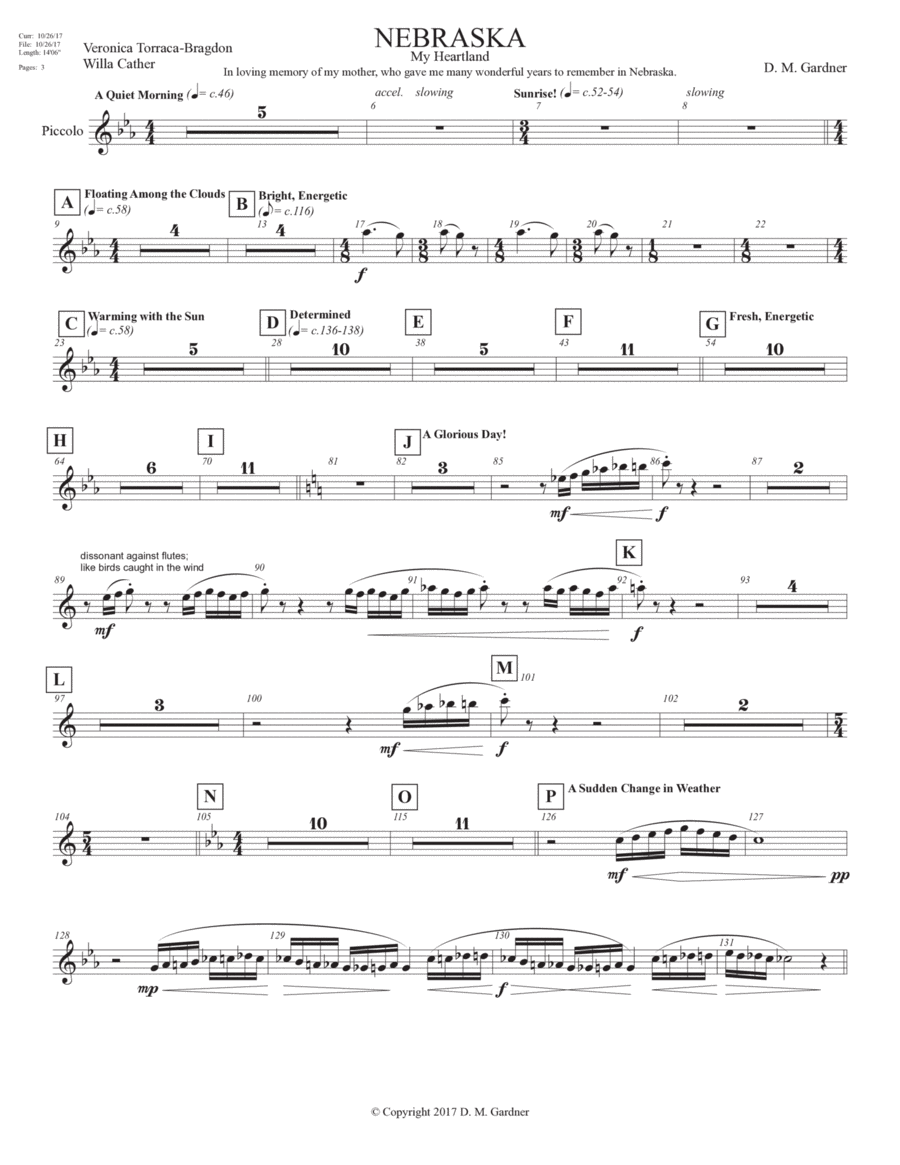Large Ensemble Choir,Voice - Digital Download SKU: A0.799662 Composed by D. M. Gardner. Contemporary. Score and parts. 109 pages. D. M. Gardner Music #3370297. Published by D. M. Gardner Music (A0.799662). INSTRUMENTAL PARTS***SCORE and CHORAL SCORE SOLD SEPARATELY***Nebraska, My Heartland was written to not only celebrate 150 years of Nebraskan history, but to express my own gratitude for all that the Midwestern way of life has to offer. It celebrates the natural beauty of the Sandhills, prairies, forests, and bluffs, along with the strength of its people, its flourishing family friendly communities, and its deep and rich traditions in the arts. I have lived near mountains, near oceans, and visited some of the most beautiful places in the world, but none of those places have ever felt as much like home as Nebraska. Nebraska, My Heartland incorporates the poetry of both Willa Cather, the famous Nebraskan poet and writer who helped the rest of America gain an appreciation for the pioneer life, and Veronica Torraca-Bragdon, a contemporary poet and friend whose heart will always belong to Nebraska. Cather’s poem, Prairie Spring was chosen because it vividly portrays the struggles of the pioneers who originally settled here, yet juxtaposes this struggle with youthful determination, and the optimism and enthusiasm brought about by hope. Veronica’s poem, titled Nebraska, is the centerpiece for the fanfare and celebration of a state that abounds with success in all of the ways that make Nebraska a great place to live. The music begins as the sun is about to rise and burst forth with the promise of a new day. It speaks of Nebraska’s natural beauty and landscapes while the sweet song of the Western Meadowlark, our state bird, drifts on the wind. Next, the changing seasons and thriving spirit of Nebraska’s people are portrayed with an energetic, youthful melody leading into a celebratory sesquicentennial fanfare. But as the seasons change, the listener is reminded that to thrive is also to persevere, and soon a storm begins to loom. First the rolling thunder, then the rain, and finally the full devastation of nature’s fury are realized by the combined forces of both ensembles. Yet, as hope springs eternal, we are reminded again of the strength of the pioneer and the roots that keep us anchored against the storm. Out of this resilience bursts forth a brilliant light signifying the future that is before us for this generation and the next, ending with words that summarize so eloquently how Nebraskans feel about their home: With loving beauty, you’ll forever shine!INSTRUMENTATION1 Piccolo2 Flute 12 Flute 22 Flute 31 Oboe 11 Oboe 21 Bassoon 11 Bassoon 24 Bb Clarinet 14 Bb Clarinet 24 Bb Clarinet 32 Bb Bass Clarinet1 Eb Alto Saxophone 11 Eb Alto Saxophone 21 Bb Tenor Saxophone1 Eb Baritone Saxophone 3 Bb Trumpet 1 3 Bb Trumpet 2 3 Bb Trumpet 3 3 Bb Trumpet 4 1 F Horn 1 1 F Horn 2 1 F Horn 3 1 F Horn 42 Trombone 12 Trombone 22 Bass trombone3 Euphonium B.C. / Baritone T.C. 6 Tuba 1 Timpani (4 drums) 5 PERCUSSIONSuspended CymbalCrash Cymbal,Wind Chimes,Orchestral Chimes,Snare Drum (3 if available), Bass Drum, *Wind Machine (optional),*Suspended Thundersheet (as available), *Large Timpani Drumhead 1 PITCHED PERCUSSION Glockenspiel,Marimba SATB & Rehearsal PianoTo learn more about the composer, please visit https://www.dmgardner.com
